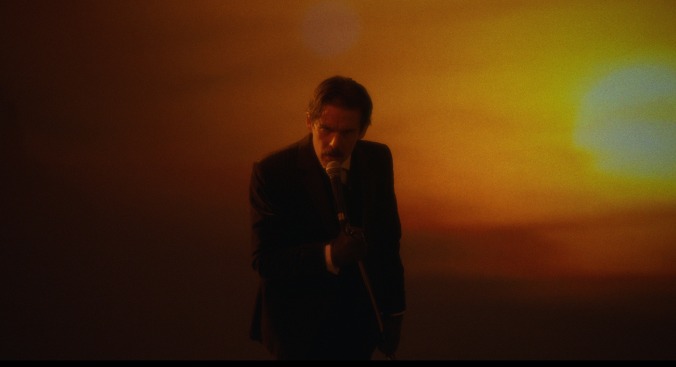In a touching scene that comes toward the end of Michael Almereyda’s postmodern quasi-biopic Tesla, the inventor Nikola Tesla (Ethan Hawke) stumbles up to a tennis court where his former financier, the tycoon J.P. Morgan (Donnie Keshawarz), is playing a game with his daughters. Speaking through a chain-link fence, Tesla makes impossible promises: He is developing a machine that can photograph thoughts and planning to create superweapons that will make war a thing of the past. Morgan is no longer interested, so Tesla wanders off to perform a karaoke rendition of Tears For Fears’ “Everybody Wants To Rule The World” while footage of sunsets is projected behind him.
Similar moments of weird poignancy are scattered throughout the film, implying more than a little self-identification. After all, if there’s any industrial futurist that artists can claim as one of their own, it’s the eccentric publicity hound Tesla, who spent his personal fortune and investors’ millions on unattainable projects that he claimed were for the betterment of humanity. Almereyda, who is at his best as an irreverent director of ideas, is savvy enough to regard this last part of the legend with skepticism. For him, Tesla’s boondoggles are the work of a lonely mind trying to prove its vision of the universe. The only pertinent questions are the same ones we ask of visionary artists, whose life’s work is rarely practical or complete.
This is an analogy that Tesla draws more than once—pointing out, for instance, that the $150,000 that Morgan lost on Tesla’s experiments with wireless power was a sum that the Wall Street titan was more than willing to spend on individual paintings for his art collection. As he has done in some of his most memorable work (including his turn-of-the-millennium update of Hamlet and his Stanley Milgram biopic Experimenter), Almereyda makes light of his own budgetary limitations: The film is filled with anachronisms meant to annoy anyone who takes biopics literally, and its less avant-garde parts look distressingly like cheap TV reenactments, done no favors by the indie cinematographer Sean Price Williams’ usual fondness for diffusion filters and underexposed faces.
What these anti-aesthetic qualities seem to be asking is whether a more expensive-looking movie would be better or any less bogus. These are somewhat intriguing questions—because we do know what a pricier version of Tesla would look like, given that the last decade has produced several slickly stylized science biopics, including The Theory Of Everything, The Current War, and Radioactive. The last of these even has moments that, on a conceptual level, wouldn’t seem out of place in Almereyda’s movie. But the fact that these films are comparable points to an unfortunate truth about Tesla: that it is, in some respects, conventional.
What’s more, the conventions that it shares with other movies are some of the clunkiest, including awkward expository dialogue and scenes of science being demonstrated to surprised extras; the latter suffer from the fact that Almereyda has precisely zero interest in the kind of showmanship that made Tesla a national celebrity. Staging this stuff in anonymously empty local-historical-society interiors doesn’t quite qualify as deconstruction. Of course, the movie is nothing if not hyper-aware of its phoniness. Some of its ideas—say, the portrayal of Thomas Edison (a superb Kyle Maclachlan) as a cultural icon who’s always in his 50s, even when he’s supposed to be in his early 30s—make for interesting commentary on how we imagine history. Others fall flat; when a group of heiresses struts into a party to the sound of dated electro-pop, the result is both obvious and trying.
However, Almereyda does grasp something that’s lost on some similarly minded projects: that theatrical distancing effects—which in Tesla include fourth-wall breaking, Google-assisted narration by Morgan’s daughter, Anne (Eve Hewson)—work best when paired with the ostensibly opposite values of believable performance. For the most part, these performances are delightfully unshowy. (Maclachlan’s Edison, for one, is head and shoulders above Benedict Cumberbatch’s irritated portrayal of the Wizard Of Menlo Park in The Current War.) Hawke, who previously worked with Almereyda on Hamlet and another Shakespeare adaptation, Cymbeline, is so soft-spoken that he even underplays Tesla’s accent.
Far from the flamboyant figure of fantasy and popular myth, this version of the inventor is totally interiorized. Tesla’s finest sequences are the ones that briefly and wordlessly conjure up a sense of isolation and quixotic pursuit: the germaphobic Tesla wiping his silverware as he sits down for a meal in front of a black-and-white photo of an empty hotel dining room; Tesla looking out on the Colorado landscape on a projection screen while a wind machine blows at his elaborately parted hair; the depiction of the Tesla Experimental Station at Colorado Springs as a fragile-looking model. As these images pop starkly against the movie’s self-conscious, occasionally artless collage, they convey a level of sympathy that’s missing from craftier, more consistent films.



 Keep scrolling for more great stories from The A.V. Club.
Keep scrolling for more great stories from The A.V. Club.